Easy Paintings to Recreate at the Metropolitan Museum of Art
Planning to visit the MET only unsure what famous artwork you should see? Don't worry, we are Met experts so we have you covered. Hither are the most famous paintings that y'all absolutely, positively should not miss when visiting the Met in New York City.
Pro Tip: This article is doesn't replace a tour, only gives yous a solid groundwork to brand a tour amend. Cheque out our Met tours and New York City tours led by the city's most passionate guides!
Top 17 Paintings At The MET
Art is about emotion. It is an artist unleashing their innermost thoughts and feelings onto canvas for all to witness, simply few to come across and empathize. If you look at a painting and don't experience anything, that is because you lot are lacking its story, which is the very reason we recommend guided tours.
You lot don't have to have an all-encompassing fine art background to appreciate fine art. What will benefit y'all the about is a guide with an extensive art groundwork who is skilled in the fine art of storytelling. They are the ones who bring the art to life so you lot remember the experience and how you felt forever.
17. Autumn Rhythm (Number 30)
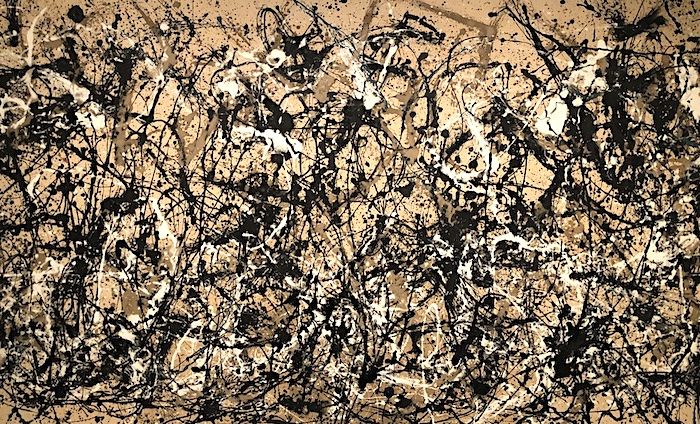
Jackson Pollock | 1950 | Enamel on canvas | Gallery 919
The number one complaint I hear nearly mod art and particularly artists similar Jackson Pollock is "I don't see anything besides some paint thrown on a canvas." Usually, the people who say this are new to modern fine art and are more than used to a coin I termed as "literal art." Literal art is a painting of a defined epitome such as a person, beast, or landscape. When yous await at those images, yous tin can identify with them, since you have seen like images throughout your life.
Top 21 Things to Meet at the MET
Artists at the plough of the 20th century were looking for new means to limited an idea. In addition, they were searching for new techniques to limited those ideas.
Autumn Rhythm (Number 30) uses a technique called pouring. Co-ordinate to the Encyclopedia Brittanica, "In 1947 Pollock first used the procedure of pouring or dripping pigment onto a flat sheet in stages, often alternate weeks of painting with weeks of contemplating before he finished a canvass. This process allowed him to record the force and scope of his concrete gesture in trajectories of enamel or aluminum paint."
The Met official archives says this well-nigh the painting, "This piece of work'due south title suggests not only the month in which he painted it (October), but too an alignment with nature'south abiding flux." I couldn't agree more than. Today, acrylic pouring is gaining in popularity, and it's probably safe to say it was inspired past works such as this.
I intend to paint large movable pictures which volition function between the easel and the mural…the trend of modern feeling is towards the wall motion-picture show or mural.
Jackson Pollock
16. Composition
Piet Mondrian | 1921 | Oil on canvass | Gallery 912
If you like clean, cutting edges and geometrical shapes and so Piet Mondrian is the painter for you lot!
Piet Mondrian grew upwards in Holland and experimented with many different styles from forms of impressionism to Abstract Art. However he remains well-nigh famous for his cosmos of the fashion called neoplasticism. According to the Official Archives of the Tate Museum, "From the Dutch 'de nieuwe beelding', neoplasticism basically means new art (painting and sculpture are plastic arts). It is too applied to the piece of work of the De Stijl circle of artists, at least up to Mondrian's secession from the grouping in 1923."
Composition is an early case of neoplasticism. Monodrian used thick, black lines to separate the painting into 11 different sizes of rectangles. The principal shades are of red and bluish. He created the lighter hues by mixing white with them.
In this way, information technology is a "What you see is what you get." This means that you meet some lines outlining geometrical shapes. Withal, if yous await deeper, the painter creates depth and brings forth certain feelings. I have put below my favorite quote from the painter himself who explains the idea better than I.
As a pure representation of the human mind, art will limited itself in an aesthetically purified, that is to say, abstract form. The new plastic thought cannot, therefore, take the form of a natural or concrete representation – this new plastic thought will ignore the particulars of appearance, that is to say, natural grade and colour. On the contrary, it should notice its expression in the abstraction of class and color, that is to say, in the straight line and the conspicuously defined principal colour.
Piet Mondrian
15. No. 13 (White, Red on Yellowish)

Mark Rothko | 1958 | Oil and acrylic with powdered pigments on canvas | Gallery 919
I will admit that I prefer Renaissance art to modern fine art. However, equally I accept gotten older (and wiser), I have learned to capeesh modern fine art more. I of the artists who has pulled me over to the dark side (or low-cal side depending on how you await at it) is Mark Rothko.
Unfortunately, he suffered from severe depression and anxiety. He was a heavy drinker and smoker, and at the age of 66, he committed suicide. Unlike many artists, he had enjoyed success during his lifetime every bit an artist.
No. 13 (White, Ruddy on Xanthous) every bit the name suggests uses three main colors. By using these bright colors, he creates a joyous mood equally opposed to other paintings where he cull darker colors for a more than brooding nature. The vertical display shows wide stripes of red and yellow which almost seem to be hovering and not touching the painting. This "halo" technique was possible by having the horizontal bands overlap background colour.
According to the Met official archives, the halo effect "is besides enhanced by the translucency of the paint, which was so diluted that information technology really saturated and stained the fibers of the canvas."
I'1000 interested only in expressing basic human emotions—tragedy, ecstasy, doom, and so on," he alleged. "And the fact that a lot of people break downward and cry when confronted with my pictures shows that I can communicate those basic human emotions…If you…are moved merely by their color relationships, and so you miss the bespeak.
Mark Rothko
14. Gertrude Stein
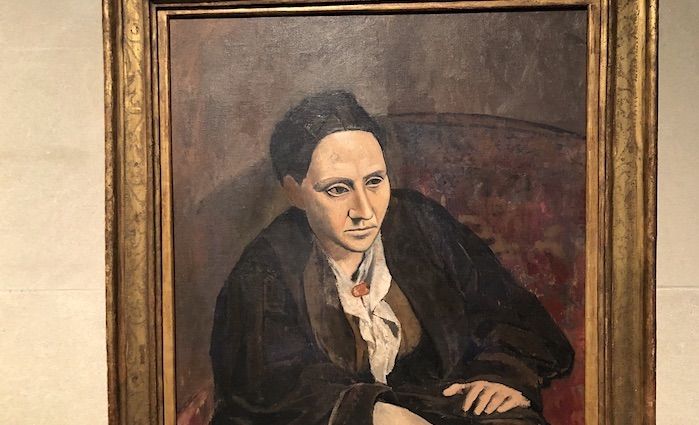
Pablo Picasso | 1906-1906 | Oil on Canvas | Gallery 830
Sometimes looking at artwork gives y'all a look into the by. For instance, before I saw this painting, I had no idea who Gertrude Stein was. Subsequently reading upwardly on her, I was fascinated by her history and life. She grew upwards between the The states and France and even when to Johns Hopkins Medical School. That sounds normal enough nowadays, but this took place in the belatedly 1800s!
She hosted a salon in Paris which drew in some of the most important literary and creative figures of the time. Co-ordinate to the Encyclopedia Brittanica, "Her literary and artistic judgments were revered, and her chance remarks could brand or destroy reputations."
According to the Met official archives, "For Picasso, Stein's early patronage and friendship were disquisitional to his success." He painted her during his so-called "Rose Menstruation." By studying this painting you can see how Picasso is slowly moving on to Cubism by reducing her body to unproblematic masses. His study of Iberian sculpture is also prevalent here by portraying her face like a mask with heavy-lidded eyes.
Einstein was the creative philosophic mind of the century, and I have been the creative literary listen of the century.
Gertrude Stein, American Writer
thirteen. Woman with a Parrot
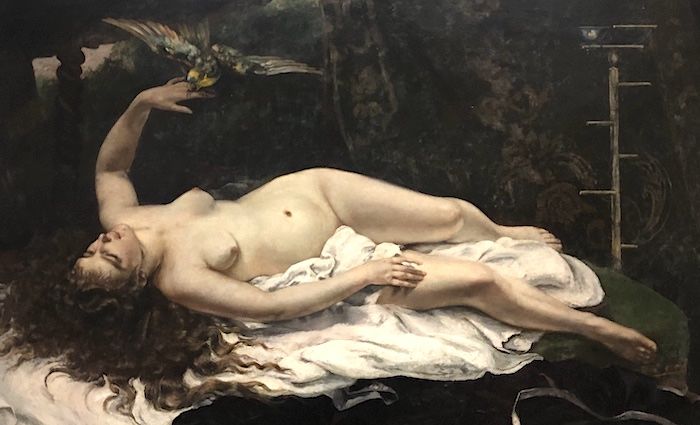
Gustave Courbet | 1866 | Oil on Canvas | Gallery 811
If Gustave Courbet had been alive in the 1980s, he probably would have been part of the Detroit Pistons "Bad Boy" squad. How can you non similar a guy who proclaims himself to be the, "proudest and virtually arrogant man in France." I love this painting but definitely loved it more one time I read that almost the creative person. Courbet was definitely out to bring stupor and awe the French art earth—and he succeeded.
It all started in 1850 when Courbet displayed a grouping of large-scale paintings depicting regular day life. To us today, this doesn't seem very boggling, but back in the day, these big-scale paintings were only used for historical genres. He farther angered critics when he used his iii sisters (who were peasants) as models for a painting where he referred to them equally demoiselles (young ladies). The critics basically told him that the girls were ugly and he needed to respect the differences in course boundaries and not call them by that noble title. He didn't listen.
Woman with a Parrot received negative reviews such as "lack of taste" as well equally about his model's "ungainly" pose and "disheveled hair." However, the younger art generation embraced him. This is was due to their mutual disdain for academic standards. Manet started a similar painting the same year and supposedly Degas carried a small photograph of this art piece in his wallet!
Courbet was such a bad-ass that he refused the award of the Legion of Award and alleged himself contained of whatever form of government. Afterward in life, due to his political activities, the government arrested him and sentenced him to half-dozen months in jail. He eventually went into voluntary exile in Switzerland and died there in 1877. What a life and definitely not the typical 1 for an artist!
12. Venus and the Lute player
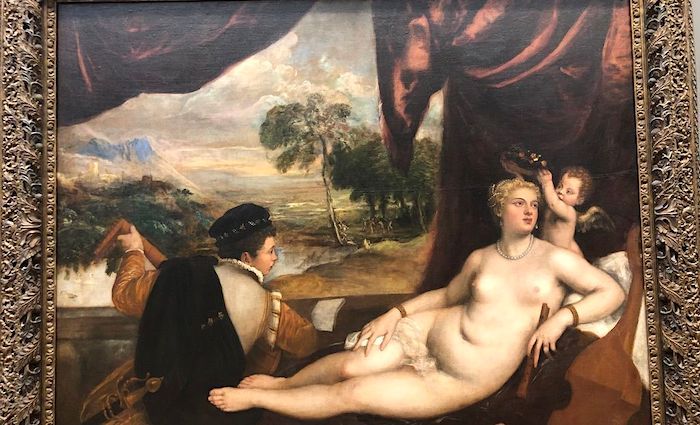
Titian | 1565-70 | Oil on Canvas | Gallery 608
Titian is by far one of the almost famous Italian Renaissance painters of all time. Known for his sensual and voluptuous paintings of women, he was the reigning artist male monarch of Venice during his lifetime.
Titian continued the transition in artwork of his time from the Virgin Mary to Venus. Whereas all paintings in the early Renaissance would take pictured the saintly female parent of god, later Renaissance works started to idolize Venus as the reigning matriarch of beauty.
Venus and the Lute Player shows Venus, the goddess of honey, surrounded past a lute player and her son Cupid. In Renaissance times, the lute was the become-to instrument when writing or singing songs of love. Yous can imagine the famous traveling troubadours playing their pained songs of love to any dryad who would listen to them!
Titian captures the moment here where Venus takes a intermission from the lute player who is affectionately staring at the goddess of love. At that moment, Cupid crowns Venus with a wreath of flowers.
In the background, you can encounter satyrs and nymphs dancing to the song of a shepherd. If you have seen other paintings of Titian, some of his virtually famous are those of a sensual, naked adult female in a slightly reclining pose looking off in the altitude.
According to the Met official archives, "Once believed to allude to contemporary debates concerning 'seeing' versus 'hearing' as the primary means for perceiving beauty, these pictures seem mainly to celebrate sensual pleasures."
Having learned that female person beauty, adorned or natural, would e'er observe customers, Titian pursued the theme joyously.
Will Durant, historian
eleven. Immature Mother Sewing
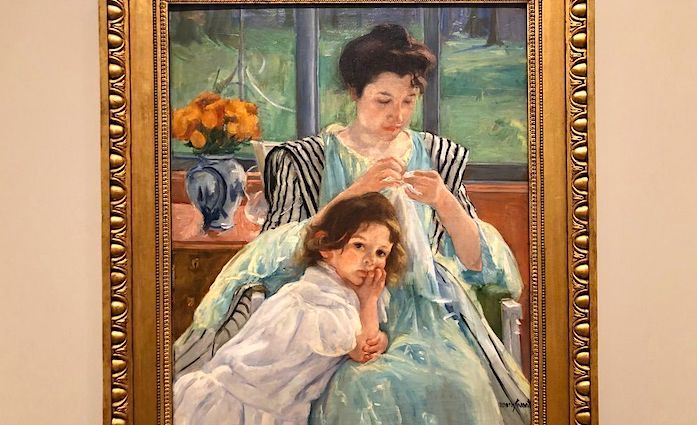
Mary Cassatt | 1900 | Oil on Canvas | Gallery 768
Mary Cassatt was one of the trailblazing female painters of the tardily 19th century. At that fourth dimension, it was still frowned upon for women to have a profession as a painter. For example, she remarked at the Pennsylvania Academy of the Fine Arts in Philadelphia that female students were patronized and were not allowed to work with alive models. Fed up, she moved to Paris, simply even in avant-garde Paris she wasn't immune to attend the Ecole des Beaux-Arts.
Therefore she started working privately with master painter Jean-Leon Gerome and later on with Charles Chaplin. She befriended many of the impressionist artists such as Degas, Pissaro, and Monet.
Towards the terminate of the 19th century, Cassatt dedicated her energies towards painting women taking care of children and also children solitary. For this painting, Cassatt brought in two unrelated models to deed every bit female parent and daughter. For many fathers, there is something extremely delicate an endearing when you encounter a young female parent and child together.
Sometimes the mundane creates a feeling of closeness to an feel we all accept felt at some point. The simple moment these 2 figures are sharing is something millions of daughters and mothers have felt throughout time. I feel that Cassatt captures that perfectly here.
Look at that little child that has merely thrown herself against her female parent's knee, regardless of the result and oblivious to the fact that she could disturb 'her mamma.' And she is quite right, she does not disturb her mother. Mamma just draws dorsum a scrap and continues to sew.
Louisine Havemeyer, purchaser of the painting in 1901
10. Study of a Young Woman
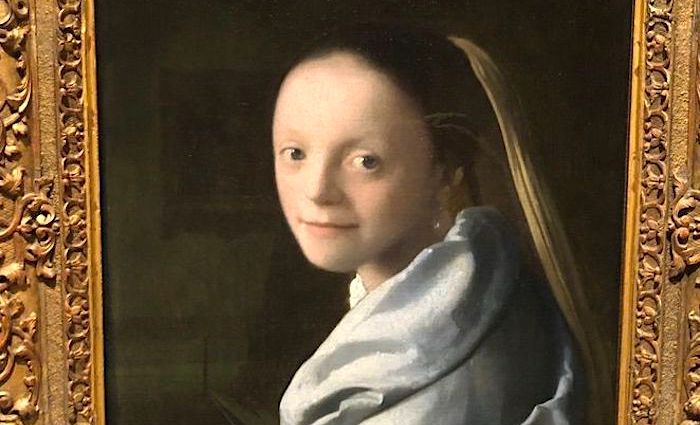
Johannes Vermeer | 1665-1667 | Oil on Canvas | Gallery 964
Compared to Dutch powerhouse painters similar Rembrandt and Franz Hals, who were already famous in their lifetime, Johannes Vermeer was not near every bit well known. His artwork became recognized only at the end of the 19th century. Outside of art circles, he remained an obscure effigy until the movie "Girl with a Pearl Earring" starring Scarlett Johansson came out in 2003.
During his lifetime Vermeer only painted 43 known paintings, and the majority of them were sold in the town of Delft where he lived. Unfortunately, he died at the young age of 43, leaving backside a wife and a whopping 11 children! Due to the financial crisis in Holland in the early 1670s, his concluding few years were quite miserable.
Study of a Young Woman was not intended to be a portrait, fifty-fifty if a live model was used. These types of paintings were chosen "tronies," a term no longer used which meant heads, faces or expressions. They were executed as a form of collector'southward items which displayed intriguing character types or exotic costumes. For instance, the blue silk around the model'south shoulders was placed intentionally for the optics of the buyer. This displayed the artists powers of invention and execution.
I notice that the optics of the daughter in the motion-picture show pierce right into your soul. However, the innocent—almost sheepish—look on her confront explains that she has no sick will towards you and is not doing it intentionally.
ix. Portrait of a Adult female with a Man at a Casement
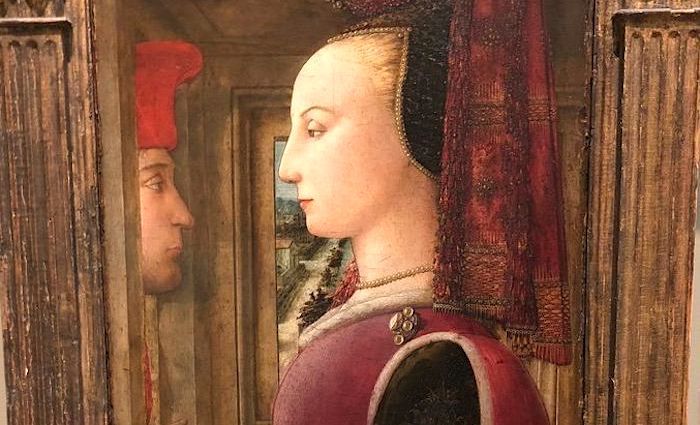
Fra Filippo Lippi | 1440 | Tempera on Forest | Gallery 602
The life of Fra Filippo Lippi is every bit fascinating every bit reading a book—if not even more than so! Orphaned at a immature age, his aunt gave him over to a monastery. Co-ordinate to Giorgio Vasari, pirates kidnapped him and held him for 18 months as a slave until he painted a portrait of his possessor.
Later in life, he had quite the scandal since he ended up having a relationship with a young nun, Lauri Buti. Plainly, he was defenseless and tortured and was only released after Cosimo de Medici stepped in to save him. On another side note, the union of the painter and his nun lover resulted in them getting married and having a son, Filippino Lippi, who was a magnificent painter in the later 15th century.
Co-ordinate to the Met official archives, "'Portrait of a Woman with a Homo at a Casement is the primeval surviving double portrait in Italian republic, the first to show the sitters in a domestic setting, and the beginning with a view onto a landscape."
On the woman's sleeve you can see the letters "Lealta" which means loyalty. In that location is a man who is staring at her (virtually uncomfortably close) at the window, so maybe this is her betrothed? His hands are touching a coat of arms, which I am sure back in the day would have been recognizable to many who viewed this painting. Many fine art historians feel that this couple may exist Lorenzo di Ranieri Scolari and Angiola di Bernardo Sapiti, who were married around 1439.
Lippi's task was complicated by the Italian preference for the contour view every bit opposed to the 3-quarter view preferred northward of the Alps.
MET Official Athenaeum
8. The Musicians
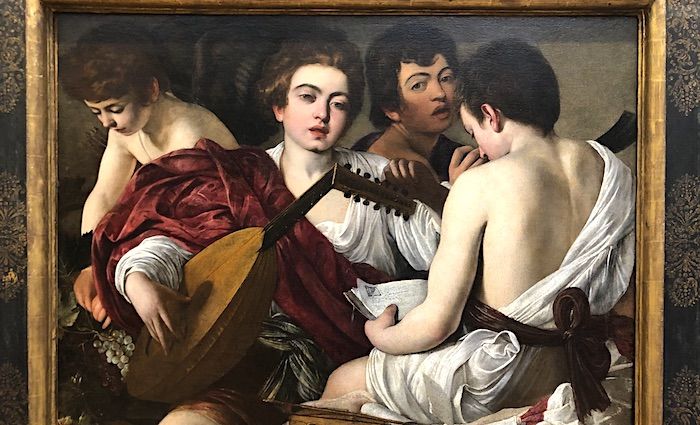
Caravaggio (Michelangelo Merisi) | 1597 | Oil on Canvass
Caravaggio would take been the kind of dude you want to hang out with at a bar, simply probably would non want to innovate to your family. Caravaggio's life was anything simply usual. For example, he walked around Rome with a sword, was supposedly part of a local gang, and even killed a man in a duel.
As a result of the killing, he was forced to flee Rome and traveled south, painting forth the way from Naples to Sicily to Malta and back. Every bit the legend goes, he was waiting for a pardon from Pope Urban Eight when ane of his enemies finally defenseless up with him and killed him in Porto Ercole.
It would exist hard non to write an entire book about this painting or about Caravaggio'south artwork in general. Up to now, in that location were established templates of how to paint saints and holy people (being painted with ideal dazzler and purity). Caravaggio smashed these concepts into the basis by painting saints and holy people as ordinary people with ordinary defects. This revolutionary idea forever changed the art earth.
The Musicians is an earlier work by the chief and resembles the paintings of youths you lot can encounter in the Borghese Gallery in Rome. A contemporary of Caravaggio, Giovanni Baglione, wrote that the artist painted, "a concert, with some youths portrayed from nature very well." Nearly likely this is the painting in question. Interestingly Caravaggio makes a cameo here as the 2d male child to the right.
7. Self Portrait with Harbinger Lid
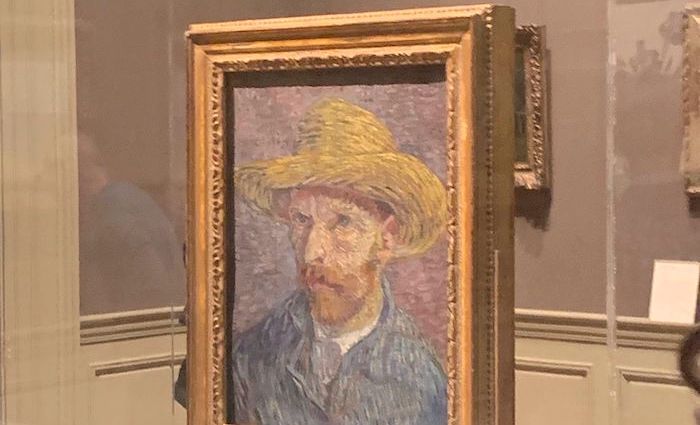
Vincent Van Gogh | 1887 | Oil on Canvas | Gallery 825
Van Gogh painted over twenty self-portraits of himself! Don't be so fast to gauge him as the biggest narcissist on the planet, however. Many artists used themselves as models to practice on since models were quite expensive.
A classic case of Van Gogh's gifts of color and expression, this painting is deceptively simple in its design. Hundreds of tiny paint strokes requite the painting a moving, lively quality, and the uncomplicated contrasting color schemes permit the epitome of Van Gogh to pop off the canvas. The light palette and straw chapeau advise the kind of summertime days and rural subjects that were Van Gogh's obsessions during his curt life.
What many people don't know is that there is a different painting on the other side of the canvas. Van Gogh painted the Potato Peeler in 1885 and it shows a peasant peeling potatoes. In 1887, he turned the canvass over and painted himself in a harbinger hat.
I purposely bought a good plenty mirror to work from myself, for want of a model.
Vincent Van Gogh
6. Bridge Over a Pond of Water Lilies
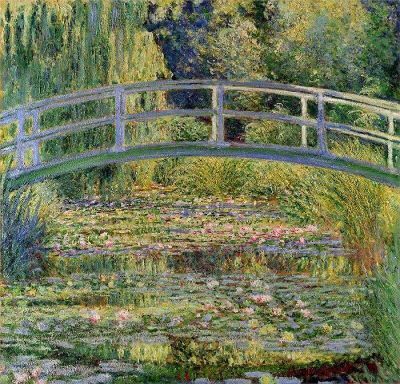
Claude Monet | 1840-1842 | Oil on Sheet | Gallery 819
This 1 is one of my personal favorites for the peace information technology brings. It also showcases Monet at the meridian of his craft. Though a unproblematic enough subject field, the creative person manages to capture the subtle differences of colour betwixt the pink lilies and the grassy foliage hanging over the h2o.
Monet was a passionate horticulturist and actually purchased belongings in Giverny exterior of Paris. The painting above depicts part of this property. Monet painted the wooden footbridge over the pond in a serial of 12 paintings with this rendition beingness his most celebrated.
A landscape does not get under your skin in 1 day. And so all of a sudden I had the revelation of how enchanting my pond was. I took upwards my palette. Since then I've hardly had whatsoever other subject.
Claude Monet
v. The Dance Class
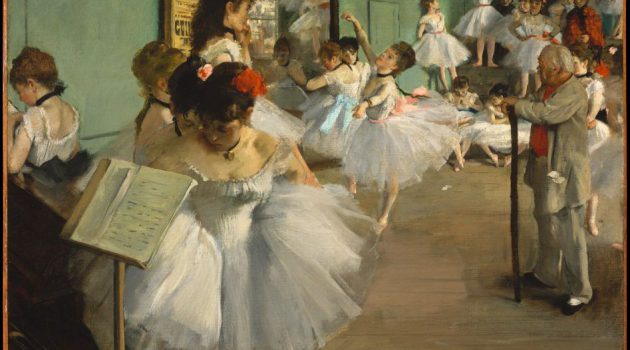
Edgar Degas | 1874 | Oil on Sheet | Gallery 815
Every fourth dimension I wait at this painting I get the ABBA song "Dancing Queen" in my head! Dance was an obsession for the painter Degas, and in that location is a like painting nigh dancers in the Musée d'Orsay. In the motility and class of graceful ballerinas, he pushed forward the possibilities of modernist art.
In the Trip the light fantastic Grade, you see a grouping of girls and their mothers who are standing around and watching the practice of one young girl. Watching the dancer is the famous ballet master Jules Perrot. While more 100 years accept gone by, yous could easily picture a scenario like this today in a ballet school—young ballerinas practicing their routine, chatting with their friends, and watching the other girls trip the light fantastic.
Yet, the rehearsal room depicted here would accept been inside the old Paris Opera, which had recently burned down at the time of the painting. Degas invites us to follow these scenarios every bit the natural lines of the painting guide our optics to the dorsum wall of the studio. The work is ultimately one of imagination.
four. The Gulf Stream
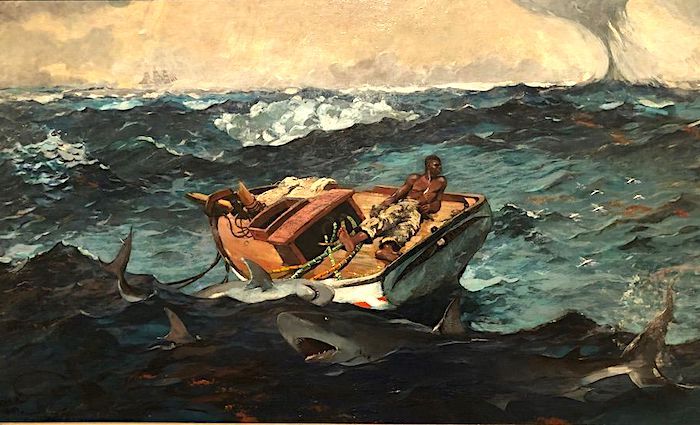
Winslow Homer | 1899 | Oil on Sail | Gallery 767
The Gulf Stream predates the popular motion picture "Jaws" by near 100 years, but the fear effect is like. To be stranded at sea is bad plenty, but adding hungry sharks to the mix is definitely worse. Personally, this ranks very high as one of my biggest fears!
In the after years of Winslow Homer's life, he lived in almost total seclusion along the coast of Maine. While he was interested in the sea, in his later years he was virtually obsessed with information technology and our vulnerability in regards to information technology.
He traveled many times during the winter to the Commonwealth of the bahamas, and there he found the inspiration for this painting. The Gulf Sttream is the warm current that flows from the north of the Atlantic down to the Southern Atlantic.
In the painting, a human being faces a fairly hopeless solution. The boat has suffered some calamity is without a mast and rudder. Next to his feet, you can see a few stalks of saccharide pikestaff which is the homo'due south merely grade of food. Unbeknownst to the man is a transport in the distant horizon which Homer later added to the composition as a sign of hopeful rescue.
Co-ordinate to the Met official athenaeum, "Painted presently later on the death of his male parent, in 1898, the painting has been interpreted equally an expression of the artist's presumed sense of bloodshed and vulnerability."
3. The Death of Socrates
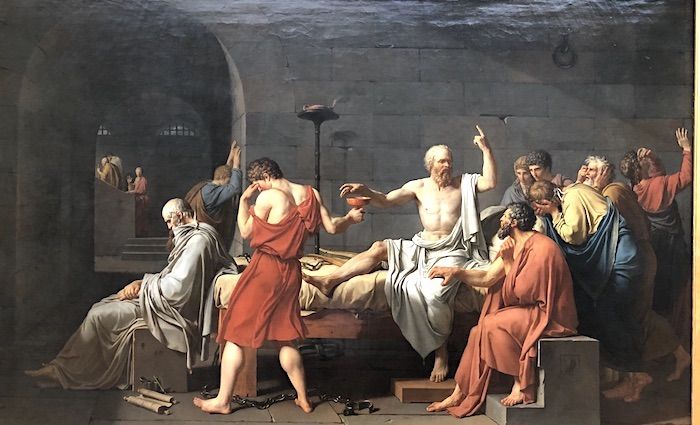
Jacques Louis David | 1787 | Oil on Canvas | Gallery 614
This touching painting will mean almost nil to the viewer without context and knowing the story. For example, the painting could be a delineation of a grouping of classical men having an interesting conversation. And at one signal a servant gives the near important man in the center a cocktail (wine back in the 24-hour interval). However, what that man is giving him is the poison hemlock!
Socrates (470-390 BC) was one of the virtually disruptive philosophers in classical times. His most famous student was Plato who recorded the death scene of Socrates in his work Phaedo. Convicted of impiety, he was sentenced to death. He could have recanted only seemed to die willingly by drinking the poison. Every bit Plato tells it, Socrates surrounded himself by his closest pupils and discussed the immortality of the soul as he drank the deadly elixir.
The creative person, Jacques Louis David, lost his begetter to a duel. His uncles cared for him, and it was obvious that he possessed great talent in the arts. In his early on artistic years, he had many trials and tribulations and even tried to commit suicide by starvation. Eventually, he won a scholarship to report in Rome, and that'due south when he began to bloom.
David became one of the most important Neoclassicist painters of the period. For The Expiry of Socrates, he consulted antiquarian scholars in club to give a 18-carat representation of the furniture and even clothing of that time. During the revolution and after he became famous as the official painter of Napoleon and his masterpiece Coronation of Napoleon.
The art of antiquity will not seduce me, for information technology lacks liveliness.
Jacques Louis David
2. Washington Crossing the Delaware

Emanuel Leutze | 1851 | Oil on Canvass | Gallery 760
This paining is arguably one of the most famous pictures of American patriotism (at least for me). Washington Crossing the Delaware is emblematic of perseverance in the face of great odds. This big canvas painting has been copied and recopied, parodied, and celebrated countless times in its history.
Though painted almost one hundred years after the events information technology depicts, the painting presents Washington'due south perilous journey across the frozen Delaware river with immediacy and passion. Depleted and short on morale, the men of Washington'due south company crossed Delaware in a surprise attack on enemy troops quartered in Trenton, New Jersey on Christmas Mean solar day in 1776.
A fire actually damaged the painting in Leutze'south studio in 1850. It was again damaged in a bombing raid in 1942 and thankfully is all the same with us today! In 1851, Marshall O. Roberts bought the painting for $10,000. According to Official Data, that would be a whopping $342,000 today!
1. Julie Le Brun Looking in a Mirror
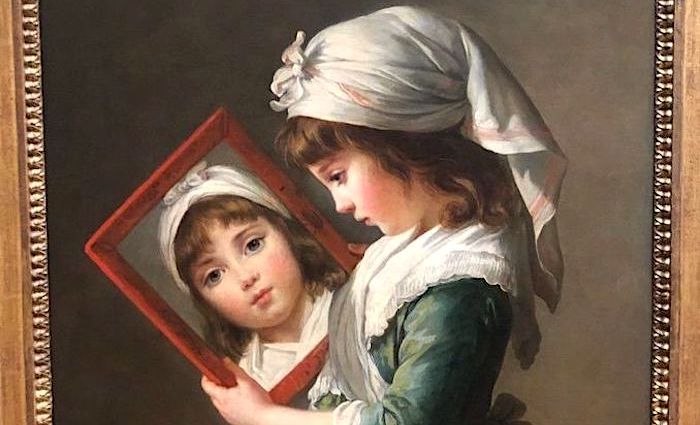
Elisabeth Louise Vigée Le Brun | 1787 | Oil on Canvas | Gallery 616
Elisabeth Louise Vigée Le Brun possessed a life made for a flick. (In writing this commodity, I really looked for a moving picture nigh her and found information technology on Amazon.)
Le Brun is one of the finest 18th-century French painters and arguably one of the most of import of all woman artists. She taught herself how to paint and was extremely talented. She lived during the turbulent times of the French Revolution, yet still she accomplished slap-up success.
At just 21 years old, Elizabeth Le Brun married to a leading fine art dealer in Paris and due to his profession, she was not accepted at beginning into the prestigious Academie Royale de Peinture et de Sculpture. Even so, she only and so happened to know Queen Marie Antoinette and was admitted at the age of 28.
In one case the French Revolution broke out, she was forced to flee France since she was pretty tight with the Queen. She lived in Italian republic for a while before eventually returning to France.
Julie Le Brun Looking in a Mirror is an amazing representation of Le Brun's simply child. Le Brun made the same innovative portrait ii years earlier of her girl. The double image plays on reality versus illusion and shows fifty-fifty more so how talented an artist Le Brun actually was.
I chose this painting as number one, non simply due to its uniqueness in character, but also its impossible perspective. Le Brun'southward talent is truly on total brandish as one of the master portrait artists of the 18th century.
These portraits capture a new appreciation in late eighteenth-century Europe of babyhood as a unique, impressionable moment of life distinct from machismo.
Met Official Archives

Detect the best places to stay
Where to Stay in NYC
A swell hotel at a corking price has become the norm in this internet era. Our commodity explains what areas are the best in NYC so you can get a great deal on the perfect location!
Source: https://thetourguy.com/travel-blog/usa/new-york-city/met/top-highlights-of-the-metropolitan-museum-of-art/
0 Response to "Easy Paintings to Recreate at the Metropolitan Museum of Art"
Post a Comment